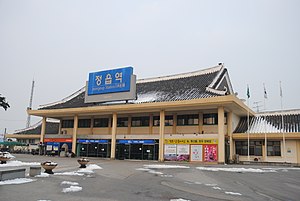This article needs additional citations for verification .(April 2025) |
The topic of this article may not meet Wikipedia's general notability guideline .(May 2024) |
 Former station building | |||||||||||
| Korean name | |||||||||||
| Hangul | 정읍역 | ||||||||||
| Hanja | |||||||||||
| Revised Romanization | Jeongeumnyeok | ||||||||||
| McCune–Reischauer | Chŏngŭmnyŏk | ||||||||||
| General information | |||||||||||
| Location | Yeonji-dong, Jeongeup, North Jeolla South Korea | ||||||||||
| Coordinates | 35°34′32.12″N126°50′33.14″E / 35.5755889°N 126.8425389°E | ||||||||||
| Operated by | Korail | ||||||||||
| Line(s) | Honam Line, Honam high-speed railway | ||||||||||
| Platforms | 2 | ||||||||||
| Tracks | 4 | ||||||||||
| Construction | |||||||||||
| Structure type | Aboveground | ||||||||||
| History | |||||||||||
| Opened | December 1, 1912 | ||||||||||
| Services | |||||||||||
| |||||||||||
Jeongeup station is a KTX station in the city of Jeongeup, South Korea. [1] It is on Honam high-speed railway and the normal speed Honam Line.